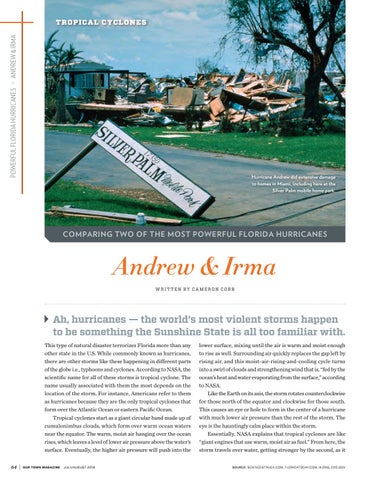64
POWERFUL FLORIDA HURRICANES >> ANDREW & IRMA
TROPICAL CYCLONES
Hurricane Andrew did extensive damage to homes in Miami, including here at the Silver Palm mobile home park.
COMPARING TWO OF THE MOST POWERFUL FLORIDA HURRICANES
Andrew & Irma W R ITTEN BY CA MERON COBB
Ah, hurricanes — the world’s most violent storms happen to be something the Sunshine State is all too familiar with. This type of natural disaster terrorizes Florida more than any other state in the U.S. While commonly known as hurricanes, there are other storms like these happening in different parts of the globe i.e., typhoons and cyclones. According to NASA, the scientific name for all of these storms is tropical cyclone. The name usually associated with them the most depends on the location of the storm. For instance, Americans refer to them as hurricanes because they are the only tropical cyclones that form over the Atlantic Ocean or eastern Pacific Ocean. Tropical cyclones start as a giant circular band made up of cumulonimbus clouds, which form over warm ocean waters near the equator. The warm, moist air hanging over the ocean rises, which leaves a level of lower air pressure above the water’s surface. Eventually, the higher air pressure will push into the 64 |
OUR TOWN MAGAZINE
July/August 2019
lower surface, mixing until the air is warm and moist enough to rise as well. Surrounding air quickly replaces the gap left by rising air, and this moist-air-rising-and-cooling cycle turns into a swirl of clouds and strengthening wind that is, “fed by the ocean’s heat and water evaporating from the surface,” according to NASA. Like the Earth on its axis, the storm rotates counterclockwise for those north of the equator and clockwise for those south. This causes an eye or hole to form in the center of a hurricane with much lower air pressure than the rest of the storm. The eye is the hauntingly calm place within the storm. Essentially, NASA explains that tropical cyclones are like “giant engines that use warm, moist air as fuel.” From here, the storm travels over water, getting stronger by the second, as it SOURCE: SCIENCESTRUCK.COM, FLORIDATODAY.COM, III.ORG, CDC.GOV
